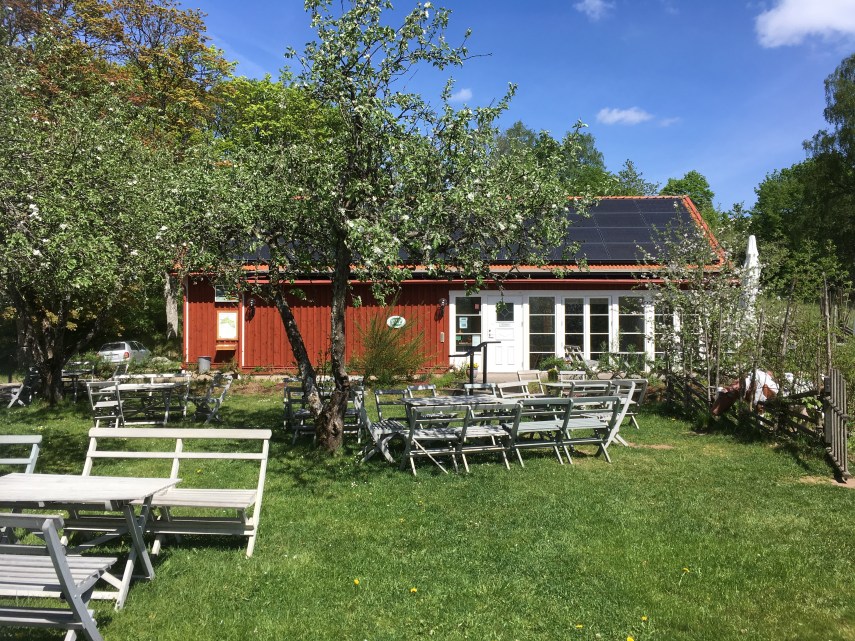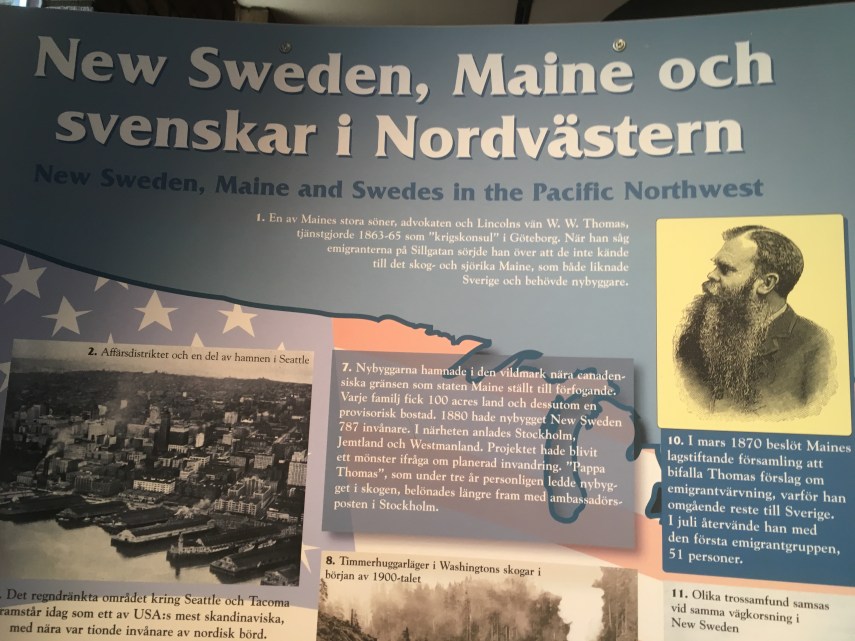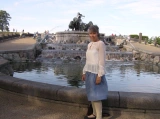The House of Emigrants
#1 post on a series on Sweden
This post is part of a series on a two-week long journey to Sweden in May 2017. My husband and I started in Gothenburg the fourth largest city in Sweden. I attended the world’s largest Half Marathon for the 12th time.

We wanted to visit our son and family 800 km away in Uppland north of Stockholm, and before arriving there, we spent time in Smaaland. On future posts, I will show you glimpses of Gothenburg, Linné the famous botanist from the Age of Enlightenment and on houses and nature in Sweden, the Ikea Museum in their first Ikea store.

One of the places that commemorate Carl von Linné in Smaaland
When my children and I lived in Sweden in the 1990s, they had to learn by heart the names of these landscapes in their fourth grade.
Once Smaaland was at the border to Denmark as we had three so-called landscapes Skaane, Halland and Blekinge. Our kings were good at building projects but bad at war, so we lost those areas in the 1600s.
Smaaland in southern Sweden is an area where the farmers had a hard job to cultivate the soil due to stony and rocky ground. In 1869 the potato harvest failed, and starvation forced many people to emigrate. Some villages were empty of people because of emigration.
From 1849-1890 one million people emigrated from Sweden to the United States. Most left Sweden of economic reasons and had their small stony lots exchanged in their new homeland with larger pieces of soil until 1890 they had to pay for the land. Then they tried to become employed in the new promised land.
At a particular time, the American authorities wanted the immigrants to come only one from a family to prove that they were able to support their family later. I guess that many tragedies had happened with whole families arriving and then not being able to manage to make a living in the new country.
We have heard of people who left Denmark, and the family never heard a word about their destiny.
In Vaexsjoe in Smaaland a museum called “The Emigrants’ House” is placed close to a lake. The permanent exhibition is called “The American Dream”. It’s shown how they got to the States. Some of the ships wrecked on their way like “Titanic” and ended tragically for many.
Pictures from Ellis Island show the humiliating ways by which they were selected. Those with an “X” written with chalk on their jackets were regarded as having mental defects. The lucky ones succeeded to get to cities like Brooklyn and Chicago and many other places. They kept together in “colonies” where the Scandinavian languages were spoken as very few had any knowledge of English.
From the book “I krig for Lincoln” in Danish “Fighting for Lincoln in the Civil War” by Anders Bo Rasmussen you can read that many of the newcomers from Scandinavia took part in the Civil War, mostly on the part of the Northern States. The author spent ten years researching the book in archives in the States. In the book, you follow certain Danish immigrants through the Civil War via their letters to their families.
Imagine having survived hunger and lack while living in Sweden, having started their own farming and then having to enrol in the army where thousands lost their lives in the horrible battlefields. Many died due to their wounds that couldn’t be adequately treated.
The young newcomers were afraid to go to war that those who survived were so much more integrated into their new country afterwards. They didn’t starve in Denmark but as only one son could inherit the farm the rest had to leave to find a job.
A Swedish genius engineer John Ericsson invented a panzer boat “USS Monitor” that came to rescue the rest of the Northern naval fleet which had been nearly destroyed by the Southern panzer boat “CSS Virginia” close to Fort Monroe in Eastern Virginia on 8 March 1862. In that way, he helped the government in winning the war.
The weather was warm and sunny the day we visited the museum. A famous Swedish writer Vilhelm Moberg has his statue outside. He traced family stories in the States in the 1930s, and his novel “The Emigrants” became a bestseller, and a TV series in Scandinavia in the 1970s and the hard life is vividly described. (The movie has English subtitles).

Seattle and Tacoma
The Swedish text in the picture says that in rainy Seattle one in ten inhabitants are of Scandinavian origin.
My friend through blogging Paula Pederson has written a book on her father’s life. Hans Pederson was a very successful contractor in Seattle and in Tacoma. I recommend her book on her search for her then famous but later forgotten father. Her story is touching as she only learnt about her biological father later in life and had to put her story together with small puzzle parts of the sparse words her mother had spoken about him along with the few items that had belonged to him.

New Sweden, Maine and Swedish in the Pacific North West
Our visit to the “Emigrant House” was the end of nearly two weeks’ tour in Sweden. We were glad a group of Americans had found the place and made it a more vivid experience. The museum has an archive with original and copies of diaries and letters from the emigrated families. Some of those who managed well in life even went back to Sweden at the end of their lives.
A few pictures from the exhibition
The texts on the wall sheets were both in Swedish and in English. Many interesting photos can be seen but in my opinion, too much text to grasp the stories of many people and places.
The exhibition would benefit from a revision of the material and focus on fewer persons and their stories in different parts of the United States and why they left their home country.
Categories: Emigrants, Historical issues, Immigrants









You are starting such an interesting series, Maria! Sweden must be something like Maine for farming—lots of rocks. after our terrible Civil War, many young men left Maine for Pennsylvania and Ohio and the movement west because the rich black soil was better for farming.
LikeLiked by 3 people
Yes Paula and so many stories still to be unearthed from old letters and News papers at attics and archives
LikeLike
We have a wonderful historian, Ken Burns, who does TV specials from old records. The first, on the US Civil War, featured the letters home of North and South soldiers. They wrote so beautifully in those days! Another on baseball, and this fall he will have one on the Vietnam War.
LikeLiked by 2 people
So interesting
LikeLike
I SO enjoy your writing. I look forward to more in this series greatly.
LikeLiked by 1 person
I am so pleased to read your comment. It inspires me to go on with the different subjects
LikeLiked by 1 person
Good. Then I feel I have achieved something!
LikeLiked by 1 person
A lovely look back at the history of hard times. I’m looking forward to the rest of this series 😊
LikeLiked by 2 people
Thank you Clive I was tempted to send the draft to you again as even this subject was a difficult one to express in English but I will save it for urgent occasions. If you see a stupid expression- please tell me
LikeLike
so interesting! thx for sharing
LikeLiked by 1 person
I have been following your posts from Bernadette’s Senior Salon, but reading this week that she needed to take a protracted break I am going around to all of the posts to follow through WordPress. I hope you will keep in touch with ADDandSoMuchMORE as well. The Salon will be greatly missed.
I love your history posts. America’s schools teach so little about your part of the world, and it is a joy for me to learn about it. Your photos are wonderful. I am looking forward to more on this series – and would LOVE to know as much as you are willing to share about health care in Sweden (the history as well as how it is handled today.)
xx,
mgh
(Madelyn Griffith-Haynie – ADDandSoMuchMORE dot com)
ADD/EFD Coach Training Field founder; ADD Coaching co-founder
“It takes a village to educate a world!”
LikeLiked by 1 person
PS. Congrats on the half-marathon!
xx,
mgh
LikeLiked by 1 person
You are always so encouraging Madelyn❤️I will keep track on you too. Bernadette has been so faithful in hosting her Senior Salon. We hope she would continue later. Many of us have become friends via that platform
LikeLiked by 1 person
Thank you, Maria. So true about the quality of the virtual friendships she facilitated. I wish I knew if she was okay – but I can certainly understand the need to step back. I have recently decided to post only twice a week – on Mondays and Fridays – to have a bit more time for some LIFE in my own life.
xx,
mgh
LikeLiked by 1 person
By the way I am Danish and live in Denmark 🇩🇰 but lived in Sweden 🇸🇪 with my children for five years the 1990s. I know it’s confusing when I write about the two countries in the same post. Norway 🇳🇴 and Finland 🇫🇮 are also two Scandinavian countries.
LikeLiked by 1 person
I did know the countries of Scandinavia – we educate at least that well here in the USA lol 🙂 – I had simply mixed up where you are currently living with the countries to which you have traveled. I appreciate the correction.
xx,
mgh
LikeLike
I am sorry. I didn’t want to let you think You didn’t know. But compared with huge USA we are small countries and placed close to each other. Each one has its own character and language even though it comes from the same root. Only the Finnish Finnländers have a completely different language. The Finnish who speak Swedish is a minority
LikeLiked by 1 person
I took no offense – and I’m sure there are readers who appreciated the info. I was unaware of the bit about language – so thanks for that!
btw- when I was a teen I used to babysit for a Danish family. The kids were first generation Americans, I believe, tho’ the mother spoke perfect American English.
One of the daughters, who became a good friend of my younger sister, later married a Secret Service Man (assigned to the President, if memory serves), so she became about as American as it gets. lol
xx,
mgh
LikeLike
I am sure you got a glimpse of the Scandinavian style when babysitting for the Danes. I was babysitting a lot and I knew quite a lot of how the different families functioned from just being there.
LikeLiked by 1 person
Not so much, surprisingly. Even their furnishings seemed similar to the other homes I saw when I took care of their children.
Except for the fact that they were a more “child-centered” household than many at the time, with extremely high expectations for the children, they seemed like a typical upper-upper middle class American family (except for the fact that the family vacationed in Denmark and had relatives there.)
xx,
mgh
LikeLiked by 1 person